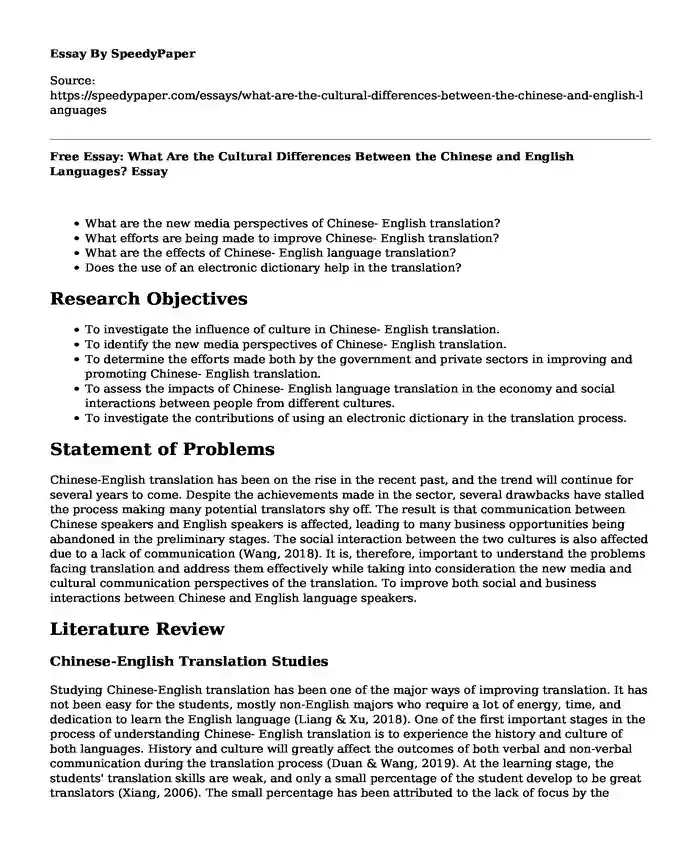
| Essay type: | Problem solution essays |
| Categories: | Culture Languages Asia Comparative literature |
| Pages: | 4 |
| Wordcount: | 1091 words |
- What are the new media perspectives of Chinese- English translation?
- What efforts are being made to improve Chinese- English translation?
- What are the effects of Chinese- English language translation?
- Does the use of an electronic dictionary help in the translation?
Research Objectives
- To investigate the influence of culture in Chinese- English translation.
- To identify the new media perspectives of Chinese- English translation.
- To determine the efforts made both by the government and private sectors in improving and promoting Chinese- English translation.
- To assess the impacts of Chinese- English language translation in the economy and social interactions between people from different cultures.
- To investigate the contributions of using an electronic dictionary in the translation process.
Statement of Problems
Chinese-English translation has been on the rise in the recent past, and the trend will continue for several years to come. Despite the achievements made in the sector, several drawbacks have stalled the process making many potential translators shy off. The result is that communication between Chinese speakers and English speakers is affected, leading to many business opportunities being abandoned in the preliminary stages. The social interaction between the two cultures is also affected due to a lack of communication (Wang, 2018). It is, therefore, important to understand the problems facing translation and address them effectively while taking into consideration the new media and cultural communication perspectives of the translation. To improve both social and business interactions between Chinese and English language speakers.
Literature Review
Chinese-English Translation Studies
Studying Chinese-English translation has been one of the major ways of improving translation. It has not been easy for the students, mostly non-English majors who require a lot of energy, time, and dedication to learn the English language (Liang & Xu, 2018). One of the first important stages in the process of understanding Chinese- English translation is to experience the history and culture of both languages. History and culture will greatly affect the outcomes of both verbal and non-verbal communication during the translation process (Duan & Wang, 2019). At the learning stage, the students' translation skills are weak, and only a small percentage of the student develop to be great translators (Xiang, 2006). The small percentage has been attributed to the lack of focus by the students in order to fully understand the complex components of translation. The students mostly experience two major challenges in their translation studies. One is the disagreement between the students' actual communication skills and the teaching contents. The other challenge is that most students at this stage, do not pay attention to improving their translation ability (Cui, 2019). Therefore, it is important for English translation teachers to develop effective teaching methods that also incorporate cultural differences in teaching.
Culture and Translation
Understanding culture is very crucial in the process of translation. It will help a person understand the context in which a word or phrase is used, therefore, giving it the appropriate meaning during the translation (Jia, 2020). The differences in history and cultural backgrounds between the two languages have led to a difference in the meaning of certain words. For example, in Western culture, the dragon is used to represent viciousness, while for the Chinese, it is used to represent aristocrats. Another example is the dog, which is used to represent loyalty in the Western culture while in China, it has a curse meaning such as "jittering" and "doglegs" (Jian-Zhong, 2001). Understanding these differences will facilitate the proper translation of words giving them the intended meaning the speaker is referring to. The sentence structure in both languages also differs greatly and is always determined by the history and culture of the nation (Fagong, 2002). Translating the words directly without incorporating the differences in meaning brought about by cultural and historical backgrounds will lead to miscommunication between the two speakers.
Relationship between Translation and Economy
Economic growth is dependent on proper communication, which will enhance efficient negotiation between the two parties (Nikolaeva et al., 2017). The language barrier has affected business as people are unable to transact due to the lack of common knowledge. To reduce the language barrier challenge, some people have learned foreign languages to enhance their communication (Chuang, 2011). However, this has not been enough, as many more people cannot afford the classes for foreign languages. Translation has, therefore, become the easiest and most affordable way to promote economic growth between people speaking different languages. The growing number of Chinese- English translators have enhanced business between China and English-speaking countries (Jun, 2002). As a result of the business interactions, many investors have ventured into the China economy, and many Chinese have invested overseas. As a result, the China economy has grown rapidly into one of the major economies in the world. Chinese- English translation has, therefore, boosted the economic development of China (Jun, 2002).
Significance of the Study
The study of Chinese- English translation from the new media and cultural communication perspective is very important in the modern world. It allows for a better understanding of the core concepts in translation; hence better services are offered. The study is, therefore, important in improving Chinese- English translation and further contributing to economic development.
Research Methodology
For proper examination of the subject, interviews, questionnaires, and library research will be used to collect data. The interviews will be with professional Chinese- English translators. The aim of the interviews will be to understand the experience of the translators with a keen interest in the challenges of the job and key points to consider in translation. The questionnaires will have questions focusing on the experience of the translators and how they deal with cultural differences between the two languages. Comprehensive research will also be done by reviewing the works done by other scholars on the same topic. All the data received will be evaluated and statistically analyzed using the Statistical Package for Social Sciences (SPSS).
References
Bao, C. (2019, May). Solutions to Common Problems in Chinese-English Translation of Graduate Students. In 2nd Symposium on Health and Education 2019 (SOHE 2019). Atlantis Press. HYPERLINK "https://scholar.google.com/scholar?as_ylo=2016&q=chinese-english+translation&hl=en&as_sdt=0,5" \l "d=gs_qabs&u=%23p%3DoVxDYQwImo4J"https://scholar.google.com/scholar?as_ylo=2016&q=chinese-english+translation&hl=en&as_sdt=0,5#d=gs_qabs&u=%23p%3DoVxDYQwImo4J
Chuang, Y. T. (2011). The challenges of New Media Translation: a multimodal approach to website translation. Linguistics Applied, 4, 66-81. HYPERLINK "https://scholar.google.com/scholar?hl=en&as_sdt=0%2C5&q=The+challenges+of+New+Media+Translation%3A+a+multimodal+approach+to+website+translation.&btnG=" \l "d=gs_qabs&u=%23p%3DvDNaVDz4P8QJ"https://scholar.google.com/scholar?hl=en&as_sdt=0%2C5&q=The+challenges+of+New+Media+Translation%3A+a+multimodal+approach+to+website+translation.&btnG=#d=gs_qabs&u=%23p%3DvDNaVDz4P8QJ
Cui, J. (2019, April). Research on Chinese-English Translation of Chinese Folk Culture Words from a Cross-cultural Perspective. In 1st International Symposium on Education, Culture and Social Sciences (ECSS 2019). Atlantis Press. HYPERLINK "https://scholar.google.com/scholar?hl=en&as_sdt=0%2C5&q=+Research+on+Chinese-English+Translation+of+Chinese+Folk+Culture+Words+from+a+Cross-cultural+Perspective.+In+1st+International+Symposium+on+Education%2C+Culture+and+Social+Sciences+(ECSS+2019)&btnG=" \l "d=gs_qabs&u=%23p%3DGeytZ0-s--kJ"https://scholar.google.com/scholar?hl=en&as_sdt=0%2C5&q=+Research+on+Chinese-English+Translation+of+Chinese+Folk+Culture+Words+from+a+Cross-cultural+Perspective.+In+1st+International+Symposium+on+Education%2C+Culture+and+Social+Sciences+%28ECSS+2019%29&btnG=#d=gs_qabs&u=%23p%3DGeytZ0-s--kJ
Daliot-Bul, M. (2019). Uncle Leo's adventures in East Asia: A cultural perspective on translation. Target. International Journal of Translation Studies, 31(1), 25-49. HYPERLINK "https://scholar.google.com/scholar?hl=en&as_sdt=0%2C5&q=+Uncle+Leo's+adventures+in+East+Asia%3A+A+cultural+perspective+on+translation.&btnG=" \l "d=gs_qabs&u=%23p%3D3s4Xx54g6GMJ"https://scholar.google.com/scholar?hl=en&as_sdt=0%2C5&q=+Uncle+Leo%E2%80%99s+adventures+in+East+Asia%3A+A+cultural+perspective+on+translation.&btnG=#d=gs_qabs&u=%23p%3D3s4Xx54g6GMJ
Cite this page
Free Essay: What Are the Cultural Differences Between the Chinese and English Languages?. (2023, Jul 30). Retrieved from https://speedypaper.net/essays/what-are-the-cultural-differences-between-the-chinese-and-english-languages
Request Removal
If you are the original author of this essay and no longer wish to have it published on the SpeedyPaper website, please click below to request its removal:
- Between Two Cultures - Personal Experience Essay Sample
- Free Essay with Poem Analysis: Pride and Prejudice: Tintern Abbey
- Contemporary Society in Application Essay Example
- Essay Example on Japanese Culture: Exploring Ancient Traditions and Modern Flux
- Free Essay. Doughnut Economics: 7 Ways to Think Like a 21st Century Economist
- Free Essay. International Marketing: A Case Study of Farfetch UK Ltd
- Paper Example - Earth and Other Planets Similarity and Differences
Popular categories




